Twitter is a popular platform for people to share fascinating things they do, see, and read and in the process, the tweets become shared by others who view them. As many retailers have found, Twitter is a powerful platform for communicating with consumers and potential customers.
According to a new survey by Compete for Twitter, Twitter followers are likelier to make online purchases than the general public. Statista report shows that Twitter has the lowest CPM ($6.46) in online advertising. If you’re not making many sales, isn’t it time for you to launch Twitter for dropshipping?
With Twitter Shops, businesses can showcase products, driving traffic to their online stores and boost sales.
We’ve tried leveraging Twitter to build brand reputation, engage with customers, and advertise products.
In this guide, we’ll walk you through the process of dropshipping on Twitter.
Table of Contents
What is Twitter Dropshipping?
Twitter Dropshipping is a way of selling products online without keeping them in stock. Here’s how it works:
-
Set Up Shop: You create an online shop on Twitter to drive products and send traffic to your store e.g. a Shopify store.
-
Order Process: When someone buys from your store, you purchase the item from your supplier.
-
Direct Shipping: The supplier ships the product directly to the customer.
Twitter Shops is available if you operate from the US. It offers features like a 50-product Storefront and a five-product Spotlight on your profile. While you can’t check out on Twitter, it’s easy for customers to visit your store and make purchases.
Even if you don’t qualify for Twitter Shopping, you can still use Twitter to advertise your dropshipping products and boost your brand’s trustworthiness.
Learn more: What is Dropshipping?
How to Use Twitter for Dropshipping
To connect with more potential customers and expand your customer base, it’s important to use Twitter features effectively. Here, we’ll explain key strategies that dropshippers can use to increase sales, build brand loyalty, and engage with customers.
1. Create a Twitter Shop
If you’re into dropshipping, showing off your products can reel in customers. Lucky for you, Twitter now has a Twitter Shop feature. It lets business owners like you showcase products to potential buyers.
While Twitter doesn’t allow customers to check out on the platform, you can link Twitter Shop to your e-commerce site. As long as you can build a brand on Twitter and tell more people about your products, you will get more sales.
You can add up to 50 products there. When shoppers see something they like, they can click on it to see more details. To buy, they just click and it takes them to your website using a built-in browser.
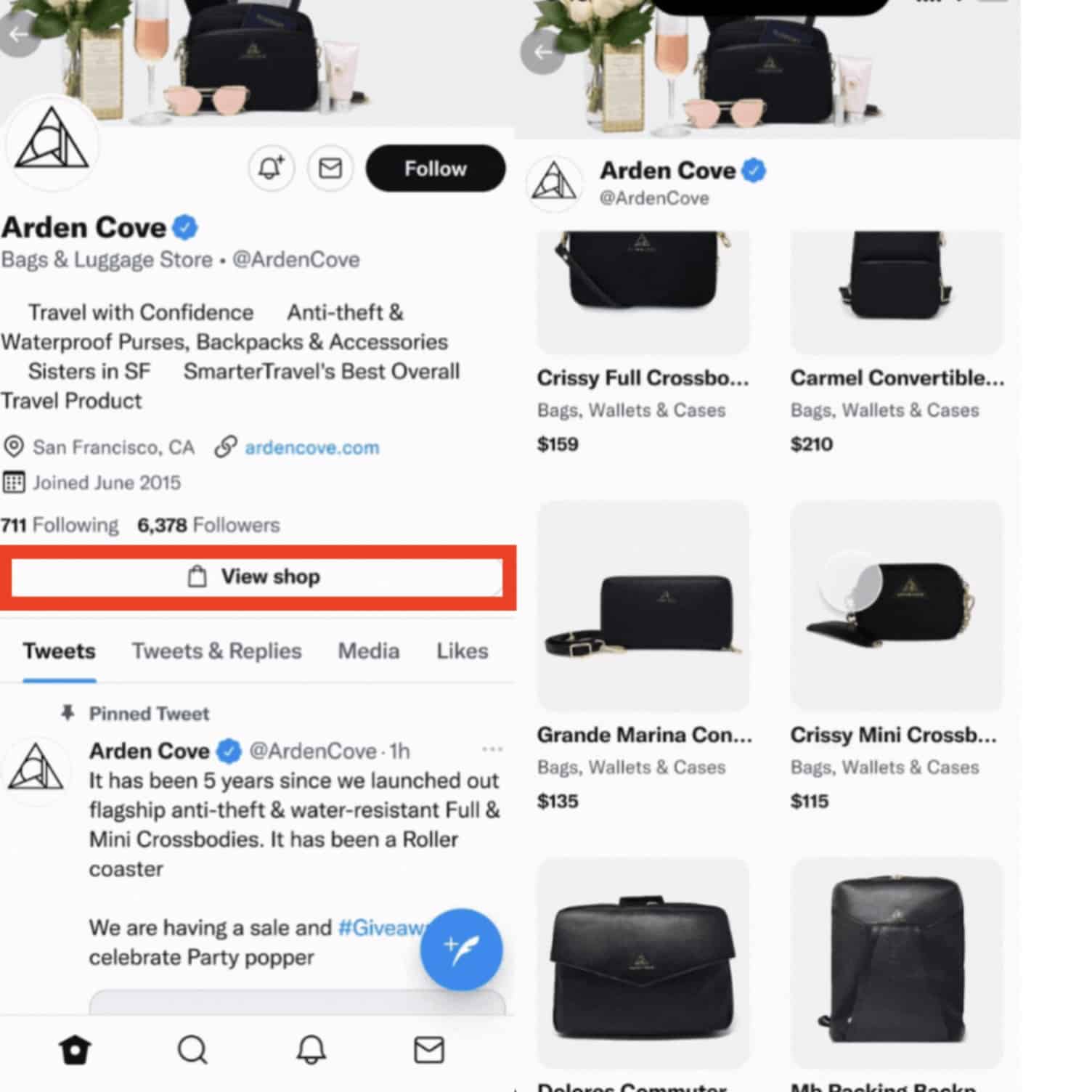
You can put five products on your Twitter profile in a swipeable section. That way, customers can easily see what you sell. If they like something, they can click on it and go straight to the product page on your website using the Twitter app. From there, they can buy it hassle-free!
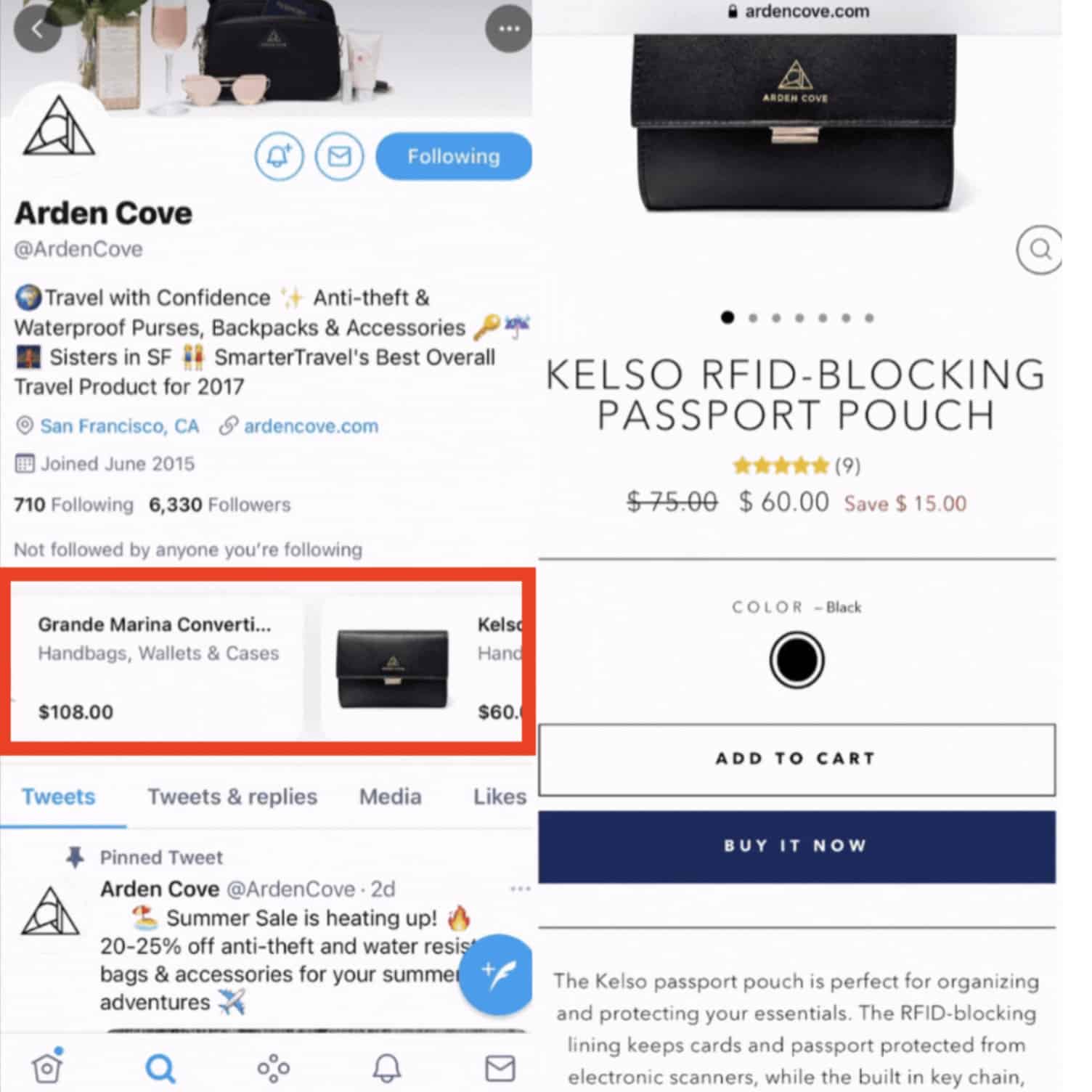
To use Twitter Shops, here’s what you need:
- A business based in the United States
- Not a state-affiliated media entity
- Selling physical products (no digital stuff or services)
And guess what? It’s all free if you meet these criteria. Since Twitter doesn’t handle sales or payments, there are no extra fees. All purchases go through your website.
Before you launch a Twitter shop, make sure your business’s Twitter account is a Professional one and that you’re logged in. After that, you can sign up for Twitter Shops by following the steps below:
- Visit the Twitter Shopping Manager at https://ads.twitter.com/shopping_manager/onboarding.
- Enter your Catalog Name.
- Read and agree to the Twitter Shopping policies.
- Add your products and create your shop.
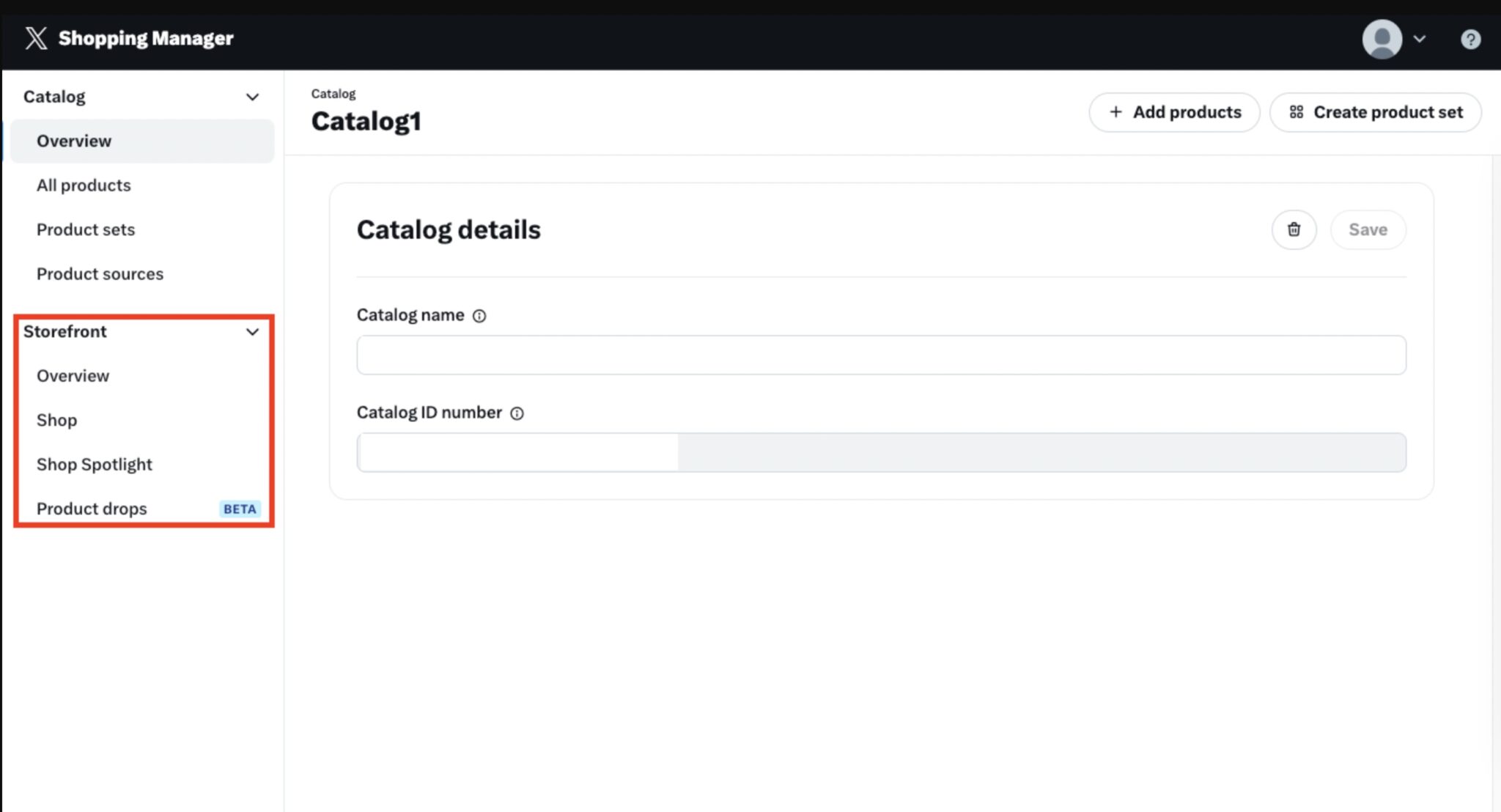
2. Optimize Your Twitter Profile
When setting up your profile, it’s important to make it look clear and professional.
Your profile is where people will decide if they want to follow you or not, so it’s crucial to make a good impression.
Here’s what you should focus on:
- Images
- Name
- Bio
- Location
- Link
- Pinned Tweet
For images:
You have two slots to fill. Make sure both are top-notch and match your brand.
- Profile Picture: Use your brand logo for this. It’s the first thing people see.
- Header Photo: Show off your best or newest products, or capture what your business is all about.
For your name:
Keep it simple and use your brand name.
For your bio:
- Keep it short and clear: Describe your business in a few words, Twitter allows 160 characters.
- Add keywords: Use relevant keywords to help customers find you.
- Use a call to action: Encourage action like ‘Check out our latest launch’ or ‘Shop now’.
For your location:
If your business operates from a specific location, consider adding it. This can be helpful for customers, but as a dropshipper, you might leave this blank unless it’s relevant to your sales area.
For your Link:
On Twitter, you can only add one link to your profile. But you might have multiple links you want to share, like other social media profiles, your main website, contact form, exclusive discounts, and more.
To solve this, you can use a “link in bio” page. These pages gather all your links in one place, making it simple for customers to find what they need.
Tools like LinkTree make creating these pages easy. You can customize them to match your business and look professional.
For your pinned tweet:
Your pinned tweet is the first thing visitors see on your profile, so it’s a prime opportunity to make an impression. It stays at the top of your feed and gets the most views.
Here are some tweets you might want to pin:
- Your business values or beliefs.
- Popular products.
- Giveaways or challenges.
- A tweet with high engagement.
- New releases.
- Countdowns to new drops.
- Testimonials or feedback from customers.

3. Check Out Your Competition
Ever heard the saying, “there’s nothing new under the sun”? Well, that applies to dropshippers who are selling generic products. After all, you’re not alone out there selling fancy pet toothbrushes or neck massagers online. Take a peek at other stores on Twitter that are doing well. See what they’re up to, how they tweak things, and how many folks are liking and sharing their tweets.
Try picking up some of their tricks for your own Twitter promotions. Also, pay attention to when they post stuff and how often. If their timing seems spot on, give it a shot yourself. If it clicks with your audience, great! Stick with it. If not, adjust and learn from their missteps.
Now, keeping tabs on your rivals can be a bit of a chore. That’s why many businesses are turning to apps like ConvertedIn to skip the manual grind.
4. Keep Up with Trends
It’s important to pay attention to what’s trending because it’s a great way to make your brand more visible.
When you join in on trending topics, your tweets show up in the trending section, which encourages other users to interact with you and your brand.
For instance, let’s take International Cat Day on August 8th. The hashtag #InternationalCatDay was all over the trending list.
In the midst of all this cat excitement, Papa John’s tweeted, “In honor of #InternationalCatDay, here’s a cat craving a slice.”
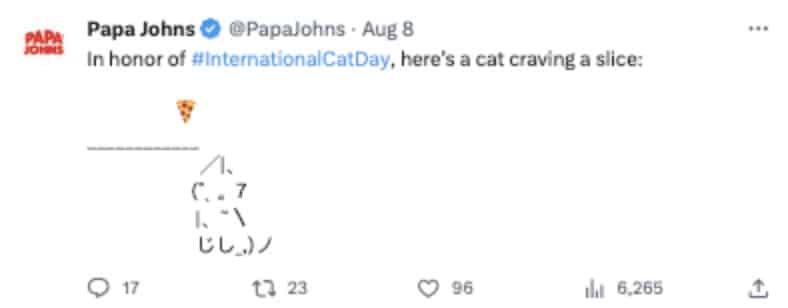
Now, Papa John’s isn’t really about cats, but they cleverly jumped into the conversation. And guess what? Over 6,000 people saw their tweet!
By doing this, Papa John’s made themselves more visible and got people who were checking out the trend hungry for pizza!
5. Keep Tweeting often!
People on Twitter love fresh content. If you keep posting regularly and keep them entertained, they’re more likely to hit that follow button.
When someone follows you, it’s your chance to connect with them. Guide them to your website and make those sales happen!
Check when your audience is most active online. Post during those times to reach more people and get more interaction.
6. Connect with Users Through Twitter Chats
Twitter chats are great for sparking conversations between businesses and customers. They let you show how responsive your brand is and learn more about what your customers think. Regular chats can help you build a strong relationship with your followers, increasing their loyalty and encouraging them to come back for more purchases.
Using Twitter’s business-to-customer feature, retailers can:
- Respond to customer issues.
- Solve buyer’s problems.
- Get to know their audience better.
7. Use Appropriate Hashtags
If you’re not using hashtags yet, start now! They’re great for getting more people to see your tweets.
Hashtags are like labels that help people find your Tweets easily. When you use hashtags, more people can see your brand, which means more potential customers might notice you.
Let’s say someone searches for a particular word. If you’ve used that word as a hashtag in your Tweet, your Tweet will pop up in their search results.
You can also make up your own hashtags to organize your Tweets. For example, you could use #BrandNameGiveaway or #BrandNameNewReleases. Then, you could run giveaways (I’ll explain more about this soon) and get lots of people using your hashtag, making it super popular.
A recent report says brands that use hashtags get 50% more engagement. But don’t overdo it – stick to less than 3 hashtags per tweet to be smart about it.
8. Reach Your Audience with Sponsored Tweets
Sometimes, even if you try hard, your ideal customers might not find you. But there’s a trick to grab their attention and keep them interested. Sponsored Tweets let you target people who are similar to your potential customers.
By sending them tweets that are relevant and interesting, you can make sure they see your message and might even buy from your online store.
9. Track Your Performance
UTM, or Urchin Tracking Module, is a helpful tool for understanding how your audience engages with your content. It adds extra info to the URLs you share, letting you track user interactions. To start, create a unique URL for each link you share on social media.
For instance, if you’re running Twitter Ads (which we’ll delve into below) along with regular tweets, you can use Google Analytics to see visitors from Twitter. But it can’t tell apart clicks from ads versus regular tweets, making it hard to track conversions and bounce rates accurately.
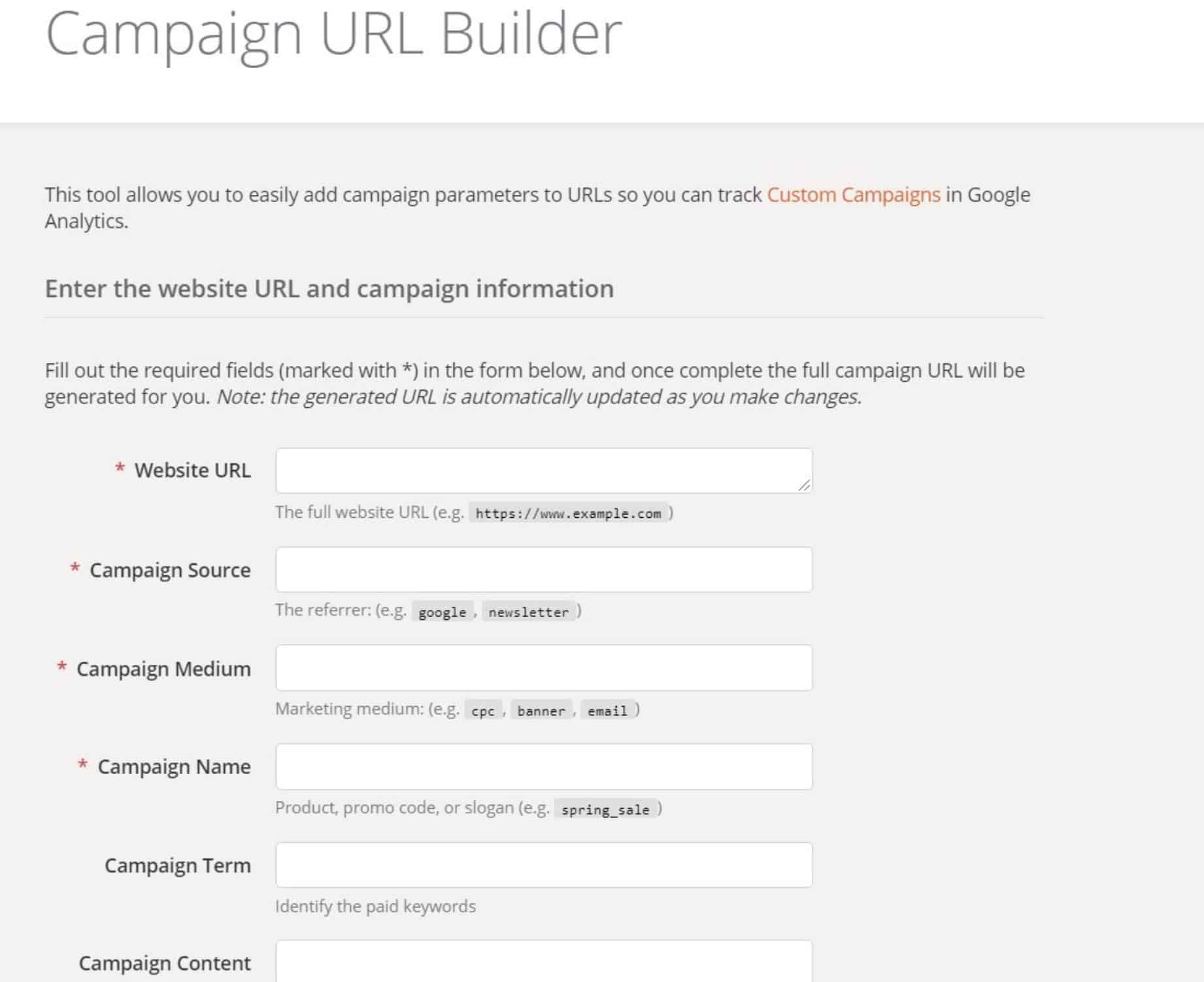
UTM tracking fixes this by giving each link a unique URL. This helps you know if the traffic is from ads, organic, or paid sources. You can set up these URLs using Google’s URL Builder tool.
How to Advertise Dropshipping Products on Twitter
If you can’t use Twitter Shops, no worries! There are many other ways you can use Twitter to tell people about your products, get them interested, and make sales.
We’ll check out some ways you can do this for free or by paying a bit, so you can pick what works best for your business.
Free Ways to Promote Your Products
You can advertise your products on Twitter without spending much money. There are two primary ways:
-
Free Gifting to Influencers: This involves giving your products to influencers to promote. They’ll share about your products with their followers, potentially boosting your sales.
-
Grow Twitter Followers: You can make a profile for your brand on Twitter and grow followers organically. This lets you showcase your products and connect with potential customers.
1. Free Gifting to Influencers
Getting your product promoted for free might sound too good to be true, but it’s possible! Here’s how it works:
-
Find the Right Influencer: Look for influencers who have a following that matches your target audience. For instance, if you’re selling beauty products, seek out beauty influencers.
-
Send Them Your Product: You’ll need to pay for the product and its shipping, but the promotion itself won’t cost you a dime.
-
Watch the Promotion Roll In: The influencer will then showcase your product through videos, images, giveaways, or challenges on platforms like Twitter.
-
Benefit from Their Influence: Their followers trust their opinions, so they might be inclined to buy your product based on the promotion.
This approach is a budget-friendly alternative to traditional influencer marketing. However, keep in mind that influencers who accept products instead of payment might have smaller or less engaged audiences. As a result, the conversion rate could be lower, but hey, it’s nearly free advertising!
2. Grow Twitter Followers
Building a strong Twitter following takes time and effort, but engaging with your audience can lead to loyal customers and supporters. Here’s how to grow your organic followers:
-
Keep Posting Regularly: Be consistent with your tweets.
-
Interact with Others: Reply to tweets and engage with people on Twitter.
-
Connect with Similar Brands: Engage with followers of brands in your industry.
-
Talk About Trending Topics: Share thoughts on popular subjects to attract attention.
-
Use Eye-Catching Visuals: Share visually appealing content to grab attention.
-
Experiment with Content: Try different types of tweets to see what resonates best.
-
Consider a Follower Campaign: Run a campaign to attract new followers.
Paid Ways to Promote Your Products
Using paid methods to advertise on Twitter can be more effective than relying solely on free methods. Here are a few ways we’ve boosted our traffic and sales using Twitter ads:
Twitter ads
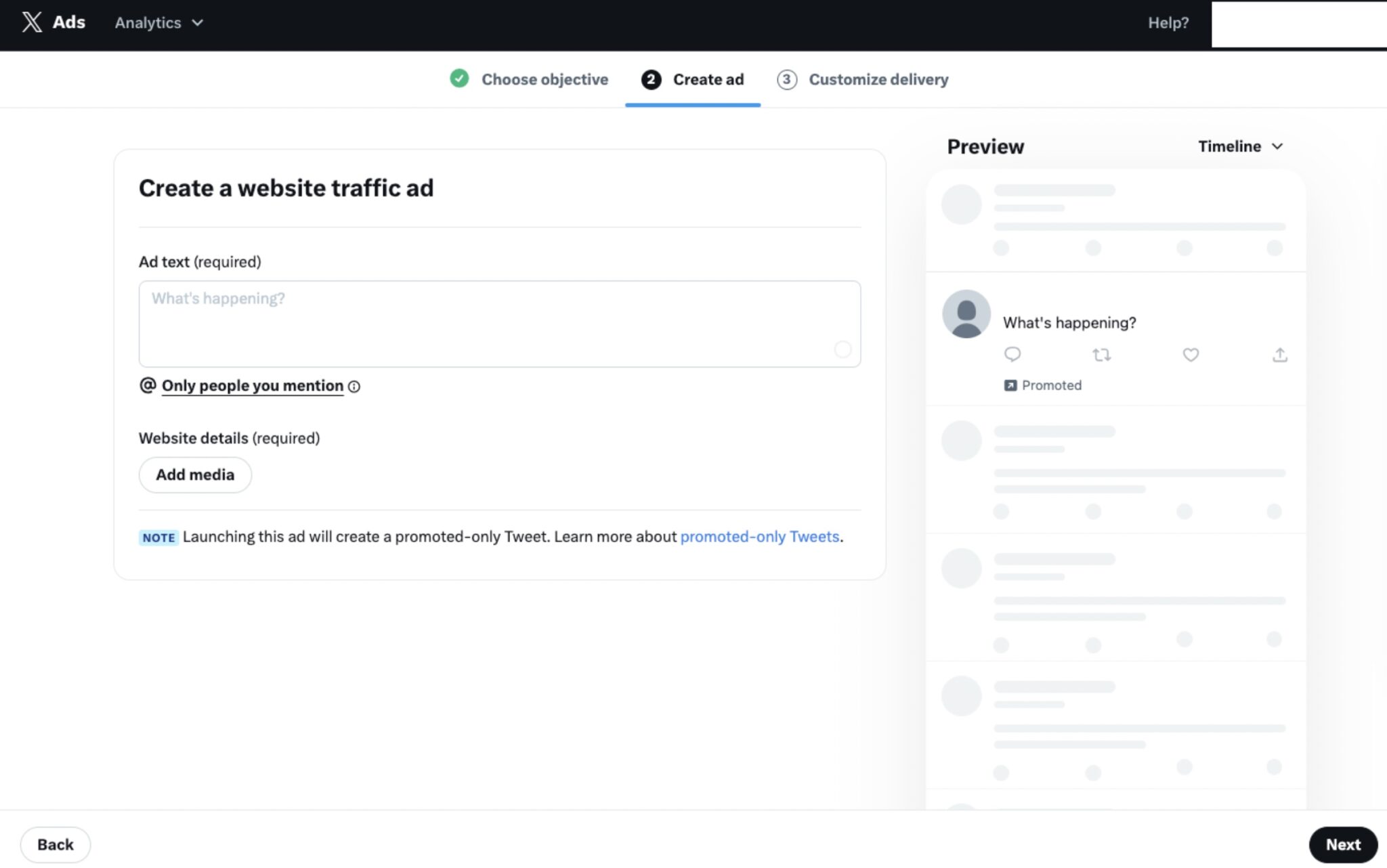
To run ads on Twitter:
- Use your Twitter account.
- Create paid ads easily.
- Choose your objective and ad content.
- Select your target audience.
- Set your budget and date range.
Twitter offers advanced targeting options such as gender, age, location, keywords, follower look-alikes, operating system, interests, and more. This helps you reach the right users, boosting conversion rates and site traffic.
Influencer Marketing
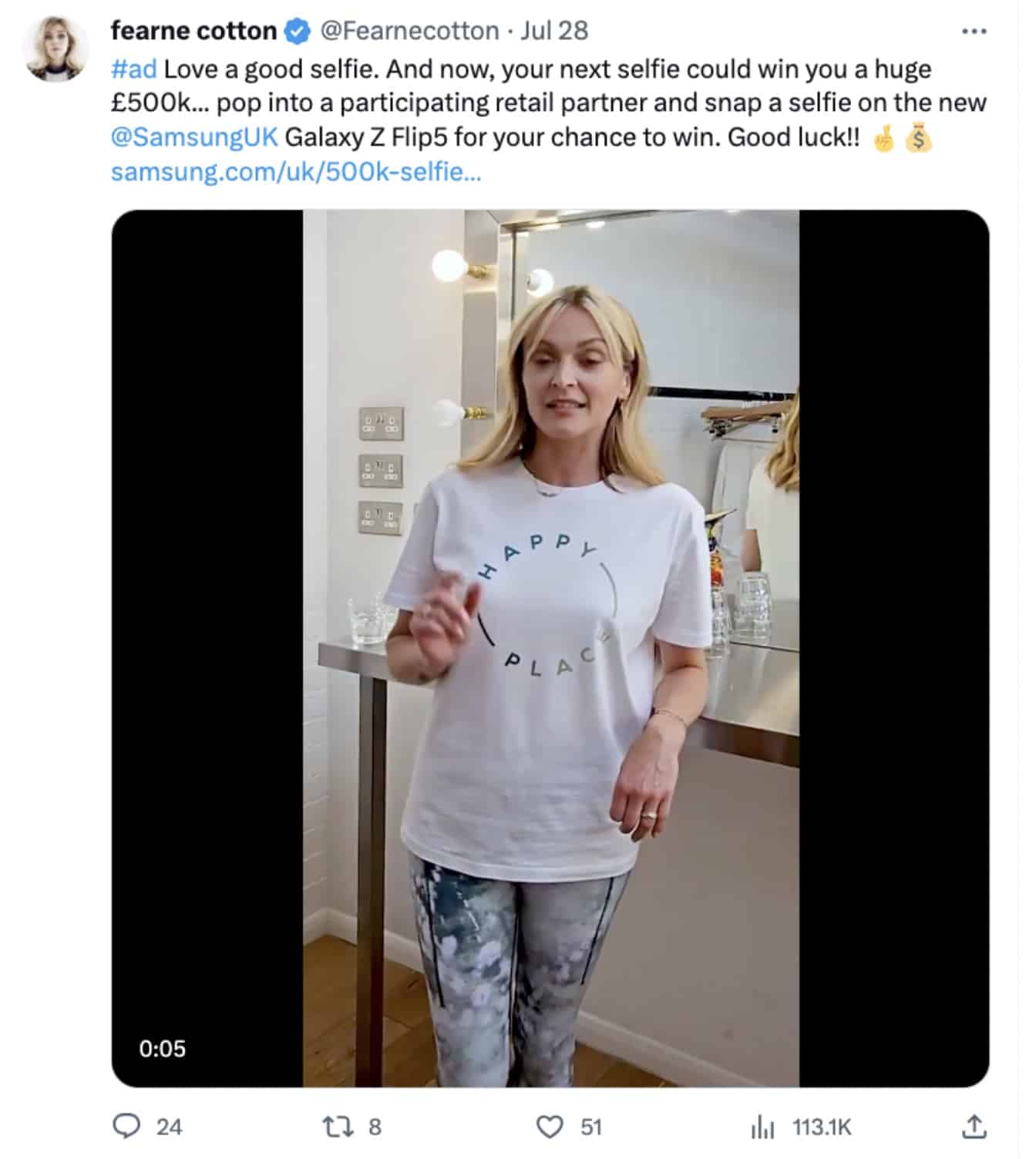
Instead of offering free products for promotion, influencer marketing involves paying influencers to promote your product.
This option is best for influencers with a highly engaged or large following. Their posts tend to have better conversion rates compared to those who accept products as payment, making it worth the investment.
The right influencers have an audience that trusts their opinions and recommendations. For example, collaborating with a fitness influencer to promote your workout gear can lead to increased trust in your products and higher sales among their followers who value their fitness advice.
Best Tips For Twitter Dropshipping
1. Share Helpful Content
When you use Twitter for your dropshipping business, make sure what you share is really useful. This way, your potential customers will like your brand and want to know more about your products.
So, try not to post random content on your profile. But what counts as valuable can vary depending on what you want for your brand. Usually, good ways to add value are:
- Sharing how-to guides and tips
- Posting funny things that make people smile
- Sharing interesting ideas that make people think
2. Engage in Social Listening
When you’re using Twitter for dropshipping, it’s important to listen to what people are saying about your business. This is called social listening. It means paying attention to conversations or mentions of your company, products, or services.
For example, let’s say you sold a neck massage device through your dropshipping business. You might discover on Twitter that some customers had a bad experience with the device, such as it being uncomfortable to use or not providing the expected relief. They could share their frustrations in tweets, mentioning your product and expressing dissatisfaction.
By joining the conversation (social listening), you can identify these issues and work on solutions, such as finding a better supplier or providing a detailed user manual in PDF format on your website.
3. Use Twitter Custom Audiences
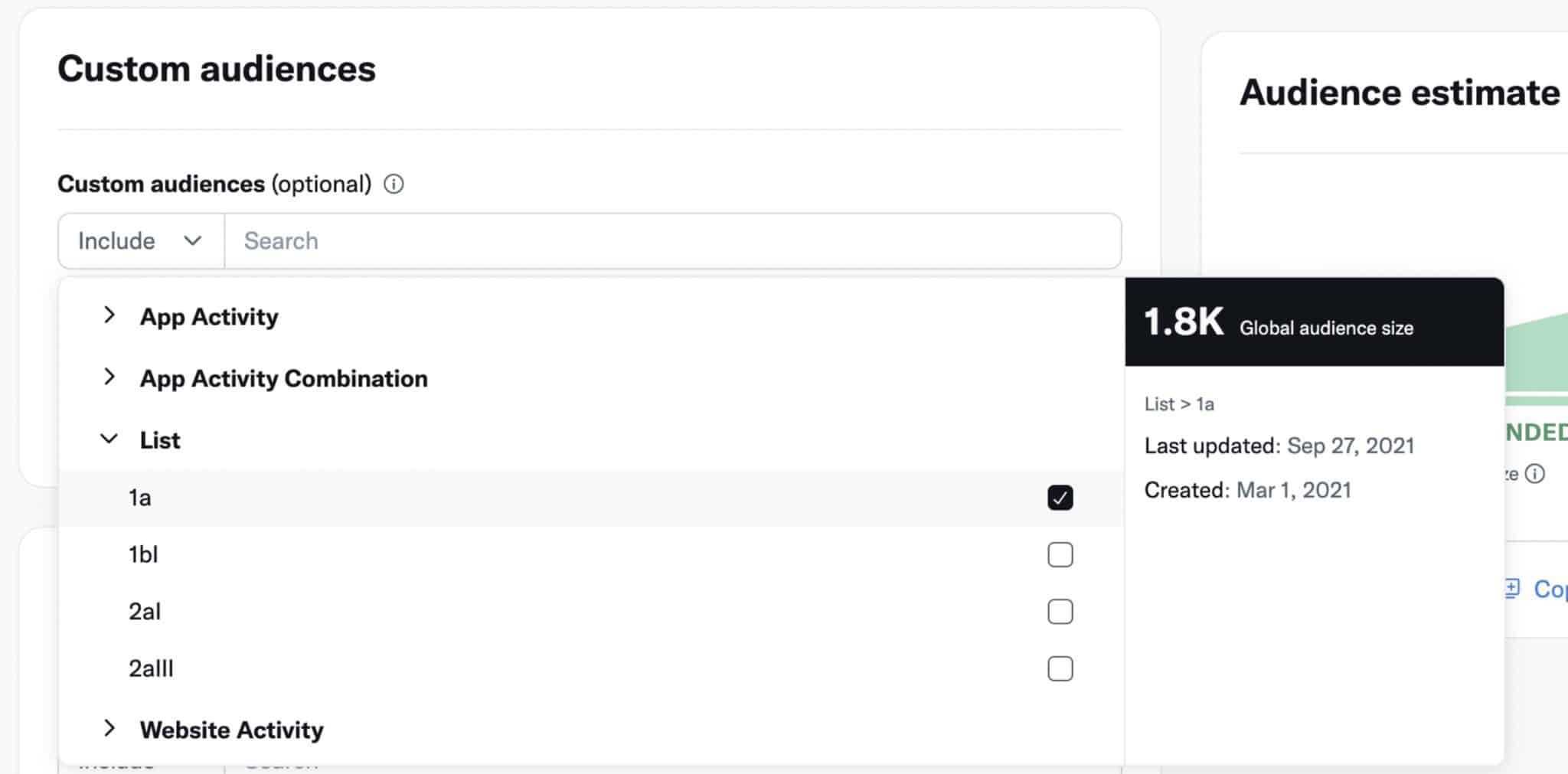
If you’re selling dropshipping products, using Custom Audiences in your Twitter Ads can help you reach a lot of the people you want to target and your current customers.
For stores that already have email lists of people who’ve visited their site, running Twitter promotions to reach them gives you another way to encourage them to buy.
4. Run Contest and Giveaways
Running challenges and giveaways can help you get more people familiar with your brand and grow your follower base.
It’s pretty straightforward. Just make a Tweet with the details, and see it catch on.
For instance, you could put out a Tweet offering a certain number of products to randomly chosen users. To participate, people might need to do a few things:
- Retweet
- Follow
- Post with a specific Hashtag
Each of these actions puts your brand in front of fresh eyes and boosts your follower count.
Remember to outline all the rules in your Tweet:
- What participants need to do exactly
- Start and end dates
- What’s included
- Any terms and conditions
Before you start, make sure to review Twitter’s guidelines for running giveaways and picking winners. And it’s a good idea to ensure your contest follows the rules and laws in your area.
5. Run a Followers Campaign
Besides using paid ads, you can run follower campaigns on Twitter. These work like ad campaigns, but instead of promoting your products, they promote your business’s Twitter profile.
Running a follower campaign helps your business reach potential customers who might be interested in what you offer.
Your profile will be promoted in various spots, like the timeline, “who to follow” list, and search results.
With follower campaigns, you only pay when someone follows your account. Any other interactions with the campaign don’t cost you anything.
Once they follow you, you can engage with them, share your business message, and hopefully turn them into customers.
Should You Use Twitter for Dropshipping?
Twitter can be great for your dropshipping business because it helps boost your brand’s visibility and credibility. But if you’re unsure whether it’s the right fit, here are some pros and cons to consider:
Pros of Using Twitter for Dropshipping
-
Enhanced Customer Trust: When customers browse your product listings on Twitter Shops and proceed to checkout, it opens your e-commerce store within the Twitter app using an in-app browser. This keeps customers within the familiar Twitter environment. This seamless experience can boost trust as customers feel more secure completing their purchase without leaving Twitter.
-
Diverse Shopping Features: Twitter Shops offers various features like Spotlight, Storefront, Product Drops, and Live Shopping. These tools empower you to showcase your products in different ways, catering to your business needs and brand image.
- Boost Click-Through Rates: Twitter Shops presents your products in an appealing manner, attracting potential customers and increasing the likelihood of them visiting your website.
-
Free to Use: Unlike some e-commerce platforms, all features of Twitter Shops come at no cost. You can set up a Storefront and utilize Spotlight without spending a dime. Since Twitter doesn’t facilitate transactions, there are no additional fees for sales made through the platform.
-
Increased Engagement: According to a Twitter test, brands using Twitter Shops experienced an average 1.8X increase in click-through rates compared to those merely linking to their website in their bio.
Cons of Using Twitter for Dropshipping
-
Additional Management: Running a business profile on Twitter requires constant attention. This means regularly sending tweets, engaging with users, and responding to inquiries and issues. Neglecting this can frustrate customers and hurt your brand.
-
Can’t Sell Directly: While you can showcase products on Twitter, you can’t directly sell through the platform. You still need to manage your e-commerce store separately, adding extra workload to keep both platforms updated.
-
Limited Advertising Effectiveness: Depending on your business and target audience, spending your ad budget on platforms like Facebook or Instagram might yield better results than Twitter. Different demographics and purposes of these platforms can affect advertising effectiveness.
-
Limited Availability: Twitter Shops is only available for US businesses, limiting its accessibility to international dropshippers.
Frequently Asked Questions
1. Can I Sell Products for Free on Twitter?
No, you can’t sell directly on Twitter. You need your own dropshipping website to sell products. But, you can use the free Shops feature to display your products and link to your website.
You can create a Storefront with up to 50 products, and when someone wants to buy, they’ll be directed to your online store.
2. Does Twitter Have a Marketplace like Facebook?
Twitter doesn’t have a general marketplace. You can set up your own Storefront with up to 50 products. Customers can then visit your website to make purchases.
3. Is Twitter Good for Dropshipping?
Twitter alone isn’t for dropshipping. You’ll need a separate platform to sell products. But, Twitter is great for showcasing and advertising your products to drive traffic to your dropshipping site.
4. Which Twitter Ads are Best for Dropshipping?
Promoted Tweets and Promoted Trends work well for dropshipping. If your budget allows, consider using video ads. You can experiment with various ad formats to find what connects best with your audience and boosts conversions.
Final Thoughts
Twitter Shops simplifies the process for customers to browse your products directly from your Twitter profile.
To enhance your brand’s visibility, you need to optimise your Twitter profile and post regularly to engage your audience.
You might also consider running Twitter ads to reach a wider audience.
While the success rate of dropshipping isn’t particularly high, if you put in the efforts, you should be able to make some sales.
If you need more guidance, sign up for my online business coaching.

Jeff Smith, Founder of High Income Source, is an online business coach with a BBA in Marketing and Entrepreneurship from the University of Pennsylvania. His online business coaching program is so popular that more than 100 students have benefited and started successful online businesses under his guidance.
Jeff started dabbling in online business while he was in college, where he began with dropshipping. After college, Jeff worked at a marketing agency and freelanced as a writer. His breakthrough came when he realized the potential of blogging, leading to a $100,000 sale of a dog-focused website. His expertise includes SEO, affiliate marketing, Amazon FBA, blogging and dropshipping.